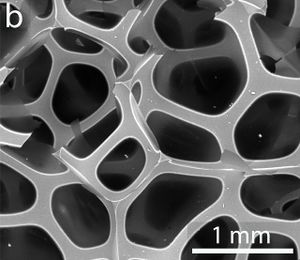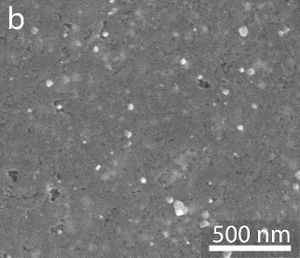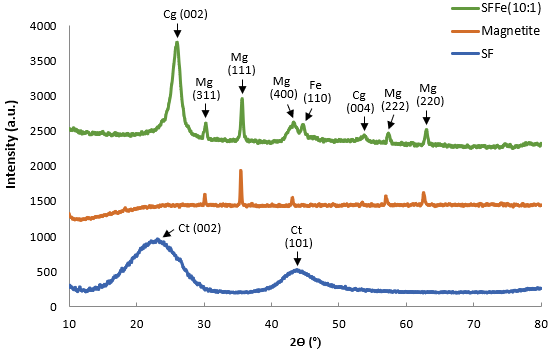1. Introduction
Carbon foams are ultralight carbonaceous materials, consisting of a structure of interconnected macroporous cells, highly adaptable to a number of applications [1-2]. The interconnected macroporous substrate provides an excellent disposition for adsorption and catalysis applications [1-4]. Moreover, additives can be included in the preparation process to modify the density, texture, mechanical strength, conductivity, and other properties of the final foam, which can thus be adapted to different applications [1-2]. Carbon foams could be excellent supports for metal and metal oxide nanoparticles that can be incorporated to their matrix either as additives during the foam preparation or afterwards, by impregnation of the resultant foam [5].
A good carbon foam precursor must undergo a fluid or pseudo-fluid state during the process of synthesis, which, combined with the production and release of gaseous compounds, or the evaporation of an added volatile foaming substance, makes possible the formation of the macroporous structure. The green foam thus obtained will be subsequently carbonized to enhance its mechanical strength. Additives, activating agents and modification of heat treatment conditions among others variables, may provide the final product with different characteristics.
Up to date coal tar, petroleum pitches and bituminous coals have been the most widely used precursors for carbon foams [6-10]. Synthetic organic polymers, such as phenol-formaldehyde, furfural resin, polyimide and polyarylacetylene, all petroleum-derived chemicals, have been also used [2, 11-12]. It would be advisable to explore more environmentally friendly procedures, and carbohydrates arise as a sustainable renewable source for carbon foams. Particularly, sucrose is a very abundant disaccharide, containing 42.1% of carbon, that easily undergoes dehydration in acidic conditions, giving rise to a macroporous cellular carbonaceous structure. To improve the foaming process by condensation reactions, nitrates have been used as foaming agents; they not only catalyses vapour releasing condensation reactions, but also generate NOx gases by decomposition, which contribute to bubble formation and development [13-14].
This work is part of a project whose main objective is to obtain versatile carbon foams from sucrose, by simple and cost-effective preparation methods. The goal is to develop methods capable of producing materials that meet different specific requirements. In particular, this work focusses on the synthesis of sucrose-derived carbon foams decorated with iron oxide nanoparticles on their surface.
2. Experimental
The materials evaluated in this work were a carbon foam (SF) previously obtained from sucrose in citric acid [15], which was used as reference material, and a carbon foam obtained using iron nitrate as additive. The sucrose-based carbon foam with 10% wt. of iron nitrate (SFFe(10:1)), was obtained from the viscous resin prepared by heating sucrose in an acidic aqueous solution of iron nitrate (50 ml) at 80 °C, with a sucrose:nitrate weight proportion of 10:1. After cooling, the resin is heated for foaming at a heating rate of 2 °C min-1 in an air circulation oven up to 170 °C, with a baking time of 20 hours at this temperature. The green foam thus obtained was named SFFe(10:1)g. Both the water vapor generated in condensation reactions and the NOx arising from iron nitrate decomposition act as foaming agents. The green foam was finally carbonized in a tubular furnace under an Ar stream (50 cm3 min-1) at a programmed temperature (4 °C min -1) up to 900 °C, temperature maintained for 2 hours, for further volatile release and the formation of the carbonaceous matrix. The carbonized foam thus obtained was named SFFe(10:1).
The morphology of the carbon materials and the iron particle size and distribution were examined by scanning electron microscopy (SEM), using a FE-SEM system Quanta FEG 650 equipped with a S/TEM detector and coupled with an X-ray dispersive energy analyzer Ametek-EDAX with an Apollo X detector.
The carbonaceous structure and the crystalline iron species were identified by powder X-ray diffraction on a Bruker D8 Advance diffractometer, equipped with a Cu-Kα X-ray source (λ = 0.154 nm), operating at 40 kV and 40 mA. Data were collected at 2θ values ranging from 10° to 80°, with a step time of 2 s and a scanning rate of 0.02° s-1. The analysis for the identification of species was carried out with the Diffrac Plus EVA program.
3. Results and Discussion
The macroporous structure of carbon foams was observed by SEM analysis using the back-scattered electron detector.
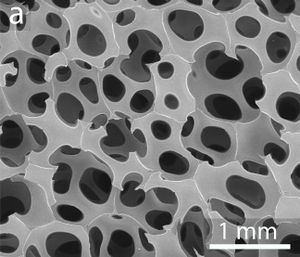
|
Figure 1 shows two micrographs representative of those acquired for the reference sucrose foam (SF) and the one obtained with the iron nitrate additive (SFFe(10:1)). The typical structure of carbon foams, already described in the literature [1-2,15], is clearly visible. Carbon foams are materials having a cellular network with cells provided with holes or windows of variable size, depending on the carbon precursor and/or the conditions under which they have been obtained. In general, this macroporosity could not be completely homogeneous for all the foams but trends can be noticed. In this case, it is clearly observed how the iron nitrate acts as a foaming agent, giving rise to a clear widening of the cell windows, which leads to thinner walls.
Particles of iron species deposited on the surface of the carbon material have also been identified in SEM micrographs. The study has been carried out on the green foam SFFe(10:1)g and on the carbonized foam SFFe(10:1).
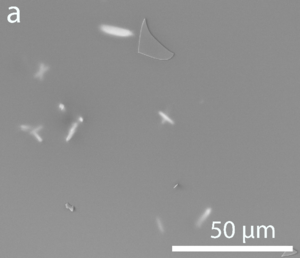
|
Figure 2 shows how the iron species formed are distributed in foams SFFe(10:1)g and SFFe(10:1). On the surface of SFFe(10:1)g, needle-shaped Fe oxides of sizes of the order of µm can be observed. The EDX analysis of these particles indicates the presence of iron oxides, while in the carbonized foam, these needle-shaped iron species disappear and iron compounds are integrated into the surface in the form of nanoparticles. The iron species present in the green foam could not be detected by DRX, but those present in the carbonized foam were identified.
In the XRD patterns of SFFe(10:1) (Figure 3), the peaks corresponding to magnetite (Fe3O4) are identified, as well as a peak that can be assigned to elemental iron (Fe0). The difference between the Fe species is clearly justified by the oxidizing and reducing atmospheres of the steps followed to obtain the green and carbonized foam, predicted from the SEM observations and confirmed by XRD analysis.
Figure 3 also shows the transformations that the carbon material undergoes in the presence of iron species, which act as a catalyst for an incipient graphitization of the material. If the XRD patterns of SF and SFFe(10:1) are compared, apart from the absence of iron species, the characteristic peaks of the carbon material show significant differences. As previously observed [15], the typical XRD patterns of the carbon foams reveal a turbostratic graphite structure with broad diffraction peaks at 2θ values of around 24 and 44°, corresponding to the crystalline reflections from (002) and (101) planes. Conversely, the XRD patterns of Fe-loaded carbon foams, exhibit a well-resolved (002) diffraction peak at 2θ = 26°, which arises from a graphitic character and is different from the broad diffuse peak observed in amorphous carbon. This incipient graphitization is catalyzed by the nanoparticles of iron oxide [16].
4. Conclusions
The use of iron nitrate as an additive to sucrose in the synthesis of carbon foams has a significant influence on the properties of the final carbon material. On one hand, iron nitrate acts as a foaming agent and, on the other, the iron species catalyze an incipient graphitization of the carbon material. Simultaneously, an in-situ growth of the iron oxide particles on the foam matrix is produced. For the iron nitrate concentration evaluated, the iron remains mainly in the form of nanodispersed magnetite on the surface of the carbon foam.
5. Acknowledgments
The authors acknowledge the funding support from Ministry of Science and Innovation of the Spain Government through the project PID2020-113558RB-C43 (MCIN/AEI/10.13039/ 501100011033) and Government of the Principado de Asturias through the project IDI/2021/000031.
6. Bibliography
[1] Inagaki, M.; Qiu, J.; Guo, Q. Carbon Foam: Preparation and Application. Carbon N. Y. 2015, 87 (C), 128–152. DOI: 10.1016/j.carbon.2015.02.021.
[2] Stojanovska, E.; Calisir, M. D.; Ozturk, N. D.; Kilic, A. Carbon-Based Foams: Preparation and Applications; Elsevier Ltd., 2018. DOI:10.1016/B978-0-08-102509-3.00003-1.
[3] Antuña-Nieto, C.; Rodríguez, E.; Lopez-Anton, M. A.; García, R.; Martínez-Tarazona, M. R. A Candidate Material for Mercury Control in Energy Production Processes: Carbon Foams Loaded with Gold. Energy 2018, 159, 630–637. DOI:10.1016/j.energy.2018.06.172.
[4] Xiao, N.; Zhou, Y.; Ling, Z.; Zhao, Z.; Qiu, J. Carbon Foams Made of in Situ Produced Carbon Nanocapsules and the Use as a Catalyst for Oxidative Dehydrogenation of Ethylbenzene. Carbon N. Y. 2013, 60, 514–522. DOI: 10.1016/j.carbon.2013.04.081.
[5] R. D. Hunter, J. Ramírez-Rico b and Z. Schnepp, Iron-catalyzed graphitization for the synthesis of nanostructured graphitic carbons, J. Mater. Chem. A, 2022, 10, 4489.
[6] Klett, J. W.; McMillan, A. D.; Gallego, N. C.; Burchell, T. D.; Walls, C. A. Effects of Heat Treatment Conditions on the Thermal Properties of Mesophase Pitch-Derived Graphitic Foams. Carbon N. Y. 2004, 42 (8–9), 1849–1852. DOI: 10.1016/j.carbon.2004.01.057.
[7] Chen, C.; Kennel, E. B.; Stiller, A. H.; Stansberry, P. G.; Zondlo, J. W. Carbon Foam Derived from Various Precursors. Carbon N. Y. 2006, 44 (8), 1535–1543. DOI: 10.1016/j.carbon.2005.12.021.
[8] Calvo, M.; García, R.; Arenillas, A.; Suárez, I.; Moinelo, S. R. Carbon Foams from Coals. A Preliminary Study. In Fuel; 2005; Vol. 84, pp 2184–2189. DOI: 10.1016/j.fuel.2005.06.008.
[9] Calvo, M.; García, R.; Moinelo, S. R. Carbon Foams from Different Coals. Energy and Fuels 2008, 22 (5), 3376–3383. DOI: 10.1021/ef8000778.
[10] Lei, S.; Guo, Q.; Shi, J.; Liu, L. Preparation of Phenolic-Based Carbon Foam with Controllable Pore Structure and High Compressive Strength. Carbon N. Y. 2010, 48 (9), 2644–2646. DOI: 10.1016/j.carbon.2010.03.017.
[11] Zhang, S. P.; Liu, M. X.; Gan, L. H.; Wu, F. R.; Xu, Z. J.; Hao, Z. X.; Chen, L. W. Synthesis of Carbon Foams with a High Compressive Strength from Arylacetylene. Xinxing Tan Cailiao/ New Carbon Mater. 2010, 25 (1), 9–14. DOI:10.1016/S1872-5805(09)60012-3.
[12] Tondi, G.; Fierro, V.; Pizzi, A.; Celzard, A. Tannin-Based Carbon Foams. Carbon N. Y. 2009, 47 (6), 1480–1492. DOI: 10.1016/j.carbon.2009.01.041.
[13] Narasimman, R.; Prabhakaran, K. Preparation of Low Density Carbon Foams by Foaming Molten Sucrose Using an Aluminium Nitrate Blowing Agent. Carbon N. Y. 2012, 50 (5), 1999–2009. DOI: 10.1016/j.carbon.2011.12.058.
[14] De Araújo, M. J. G.; Villarroel-Rocha, J.; De Souza, V. C.; Sapag, K.; Pergher, S. B. C. Carbon Foams from Sucrose Employing Different Metallic Nitrates as Blowing Agents: Application in CO2 Capture. J. Anal. Appl. Pyrolysis 2019, 141. DOI: 10.1016/j.jaap.2019.05.016.
[15] García, R.; Rodríguez, E.; Díez, M.A.; Arenillas, A.; Villanueva, S.F.; Rey-Raap, N.; Cuesta, C.; López-Antón, M.A.; Martínez-Tarazona, M.R. Synthesis of Micro- and Mesoporous Carbon Foams with Nanodispersed Metals for Adsorption and Catalysis Applications. Materials 2023, 16, 1336. DOI: 10.3390/ ma16041336.
[16] Yang, J.; Zuo, S. Facile Synthesis of Graphitic Mesoporous Carbon Materials from Sucrose. Diam. Relat. Mater. 2019, 95, 1–4, DOI:10.1016/j.diamond.2019.03.018.
Document information
Published on 30/07/23
Accepted on 09/06/23
Submitted on 19/05/23
Volume 08 - COMUNICACIONES MATCOMP21 (2022) Y MATCOMP23 (2023), Issue Núm. 1 - Caracterización - Sostenibilidad y Reciclaje, 2023
DOI: 10.23967/r.matcomp.2024.01.03
Licence: Other
Share this document
claim authorship
Are you one of the authors of this document?
